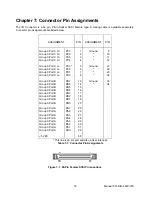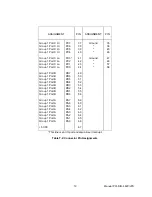
Manual PCI-DIO-48JP/JPS
10
Chapter 4: Address Selection
These cards use one address space, occupying sixteen consecutive register locations.
PCI architecture is inherently plug-and-play. This means that the BIOS or Operating System determines the
resources assigned to PCI cards rather than requiring the user to select those resources with switches or
jumpers. As a result, you cannot set or change the card’s base address or IRQ level. You can only
determine what the system has assigned.
To determine the base address that has been assigned, run the PCIFind.EXE utility program. This utility will
display a list of all of the cards detected on the PCI bus, the addresses assigned to each function on each
of the cards, and the respective IRQs allotted.
Alternatively, some operating systems (Windows95 and WindowsNT 5.0) can be queried to determine
which resources were assigned. In these operating systems, you can use either PCIFind or the Device
Manager utility from the System Properties Applet of the control panel. The cards are installed in the Data
Acquisition class of the Device Manager list. Selecting the card, clicking Properties, and then selecting the
Resources Tab will display a list of the resources allocated to the card.
PCIFind uses the Vendor ID and Device ID to identify your card, then reads the base address and IRQ
assigned. If you want to determine these yourself, the Vendor ID is 494Fh (ASCII for “I/O”) and the Device
IDs are:
PCI-DIO-48JP:
0C60h
PCI-DIO-48JPS:
0E60h
The PCI bus supports 64K of I/O address space, so your card’s addresses may be located anywhere in the
0000 to FFFF hex range.






































